Abstract
Halogenated aromatic xenobiotics such as the chlorinated and brominated biphenyls, naphthalenes, dibenzodioxins, and dibenzofurans are widespread environmental contaminants. The number, position, and nature of the halogen atoms as well as the structure of the aromatic rings influence the disposition of these chemicals in living systems. Absorption is governed primarily by the physical properties of lipophilicity and solubility. Distribution through the blood occurs by nonspecific binding to plasma proteins and cellular components. Liver and adipose tissue are the major depots. Metabolism is a prerequisite for excretion. The highly substituted isomers tend to be resistant to metabolism. The route of excretion shifts from urine to feces with increasing size and number of halogen atoms. Although pharmacokinetic modeling has allowed some predictions to be made from one compound to another or across species, more information on metabolism is required in order to improve the ability to predict the disposition in humans of this class of toxic environmental pollutants.
Full text
PDF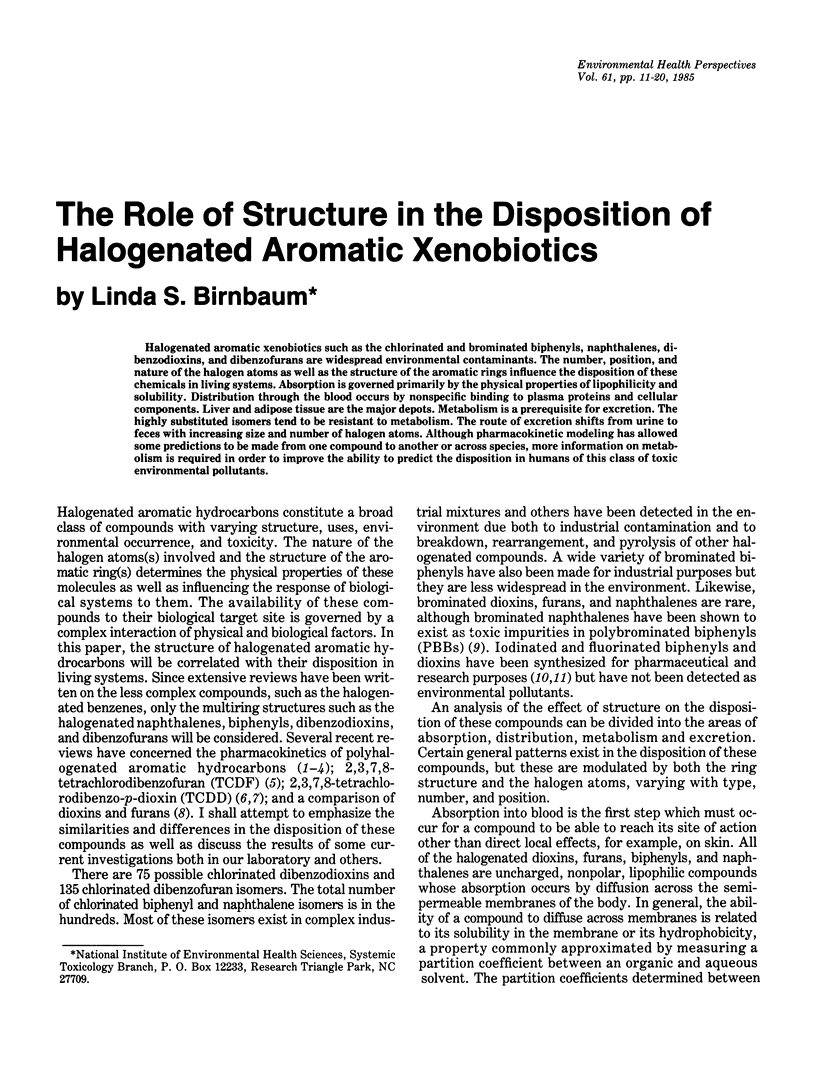
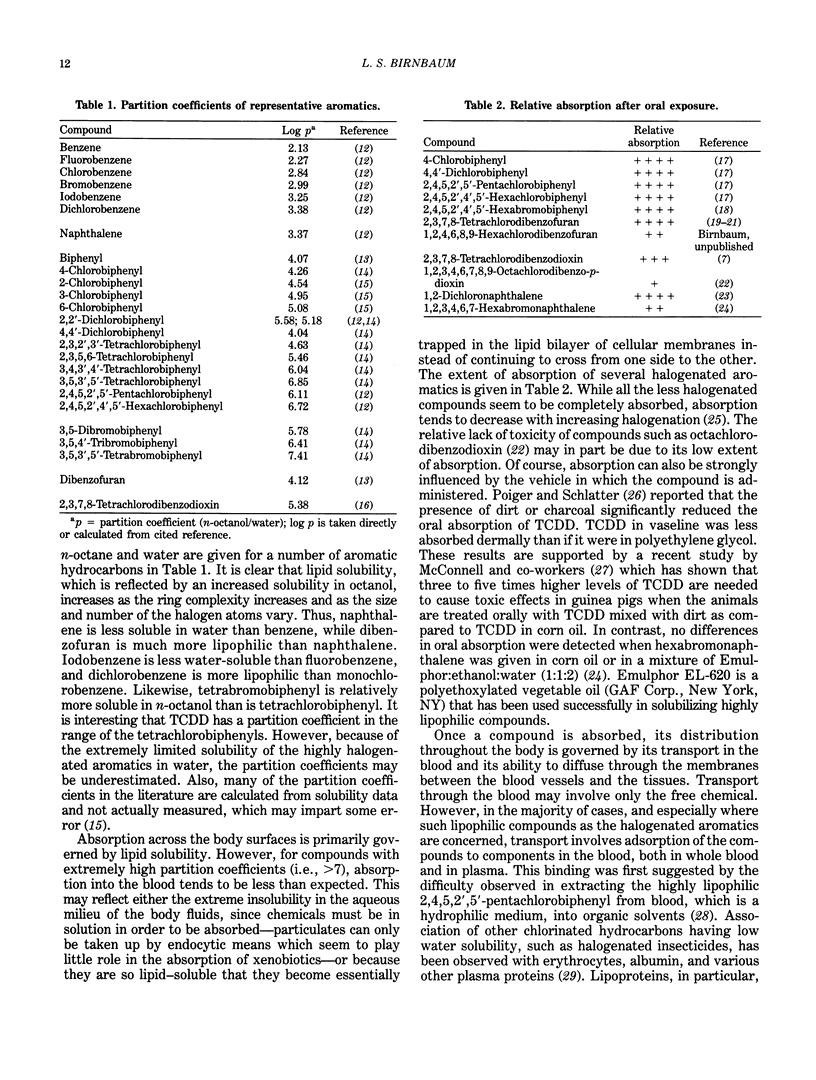
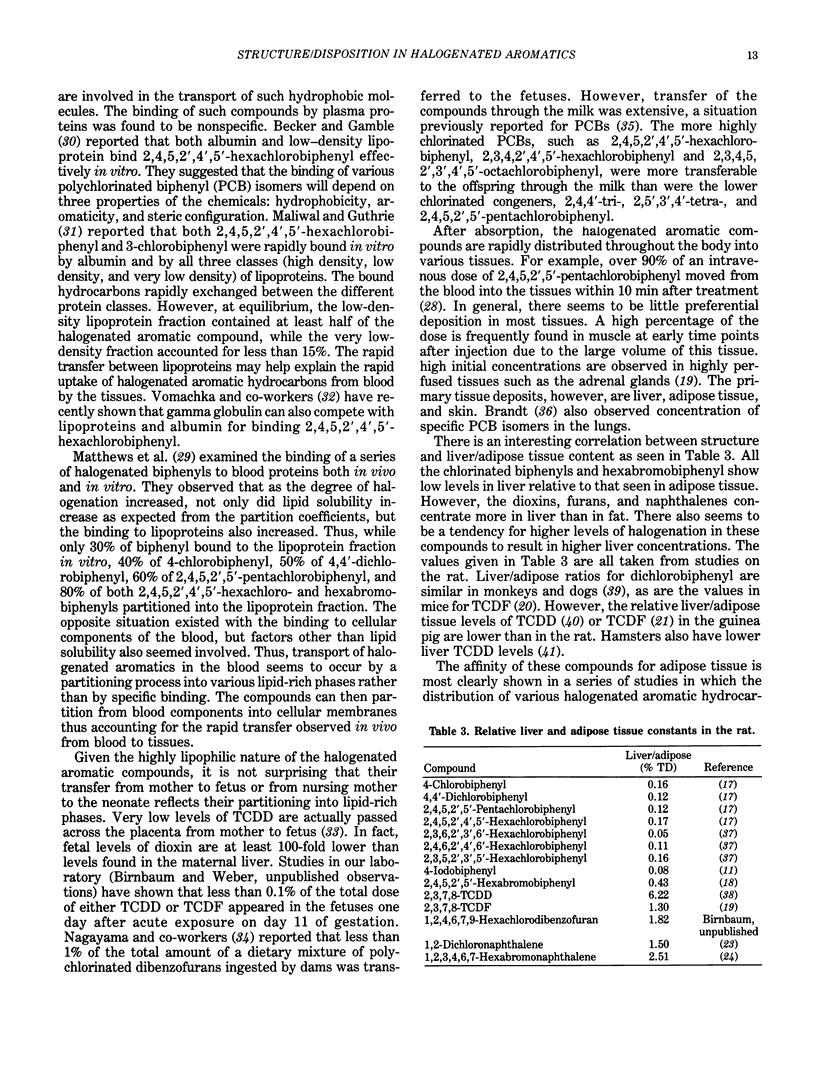
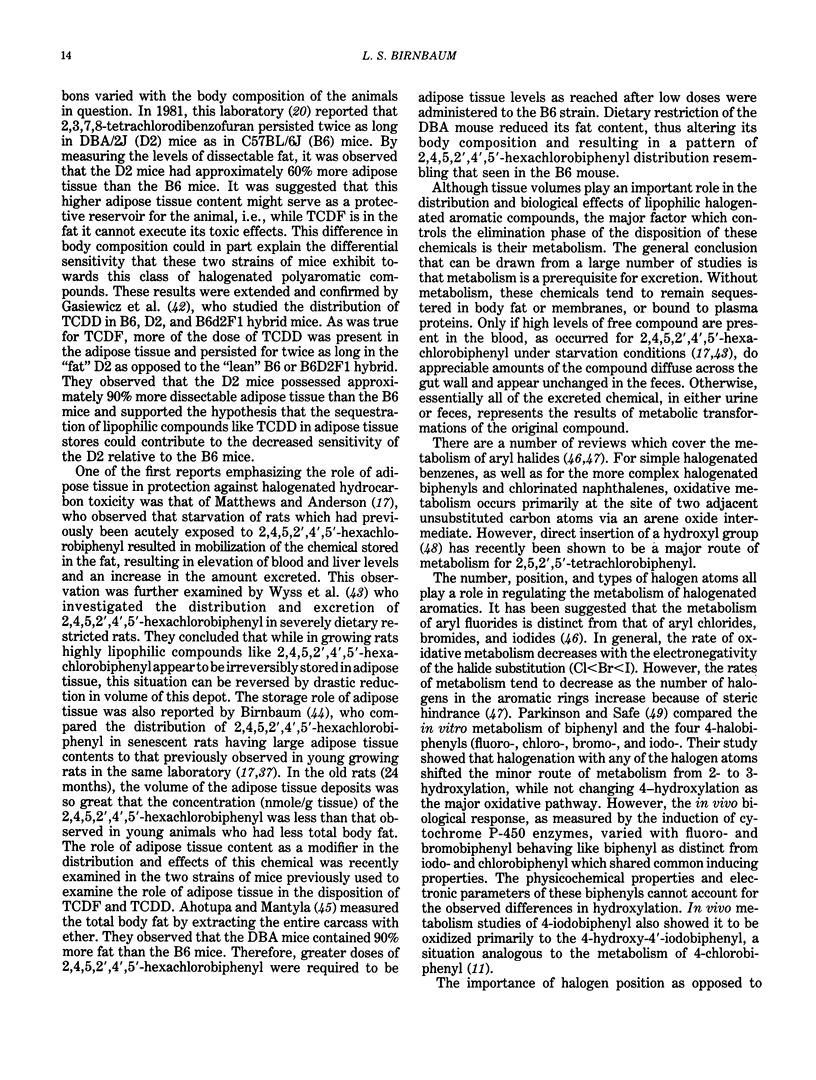
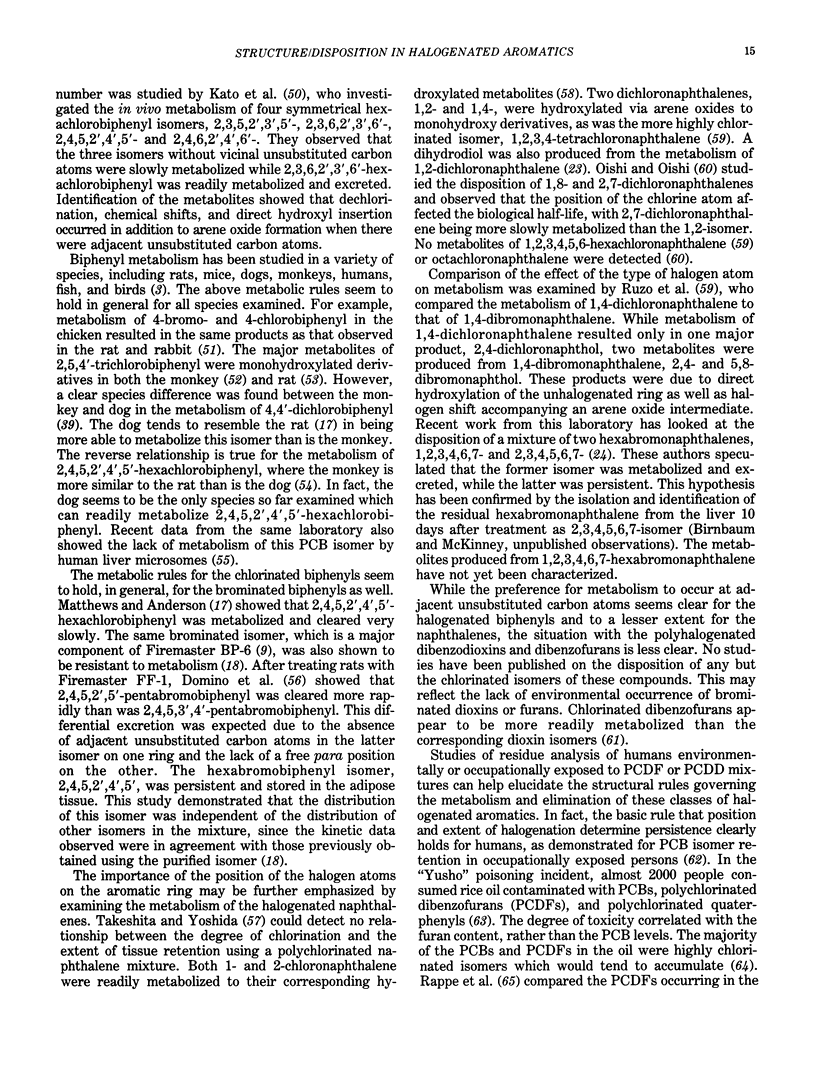
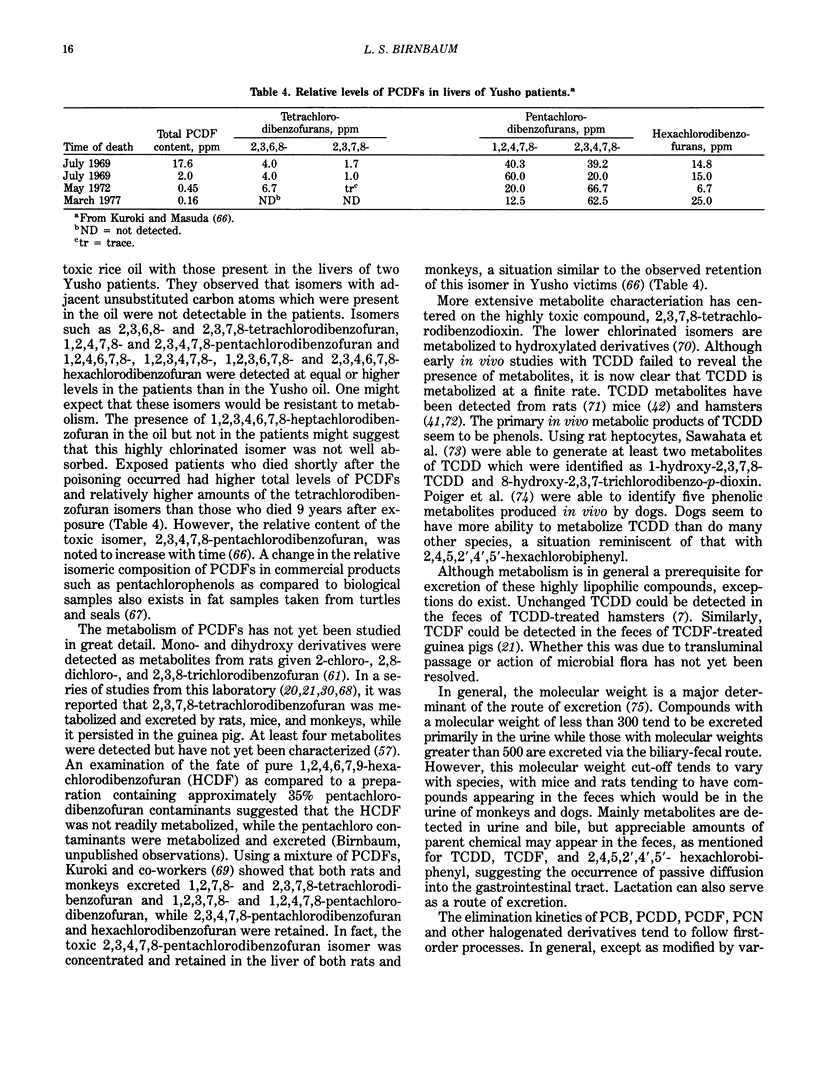
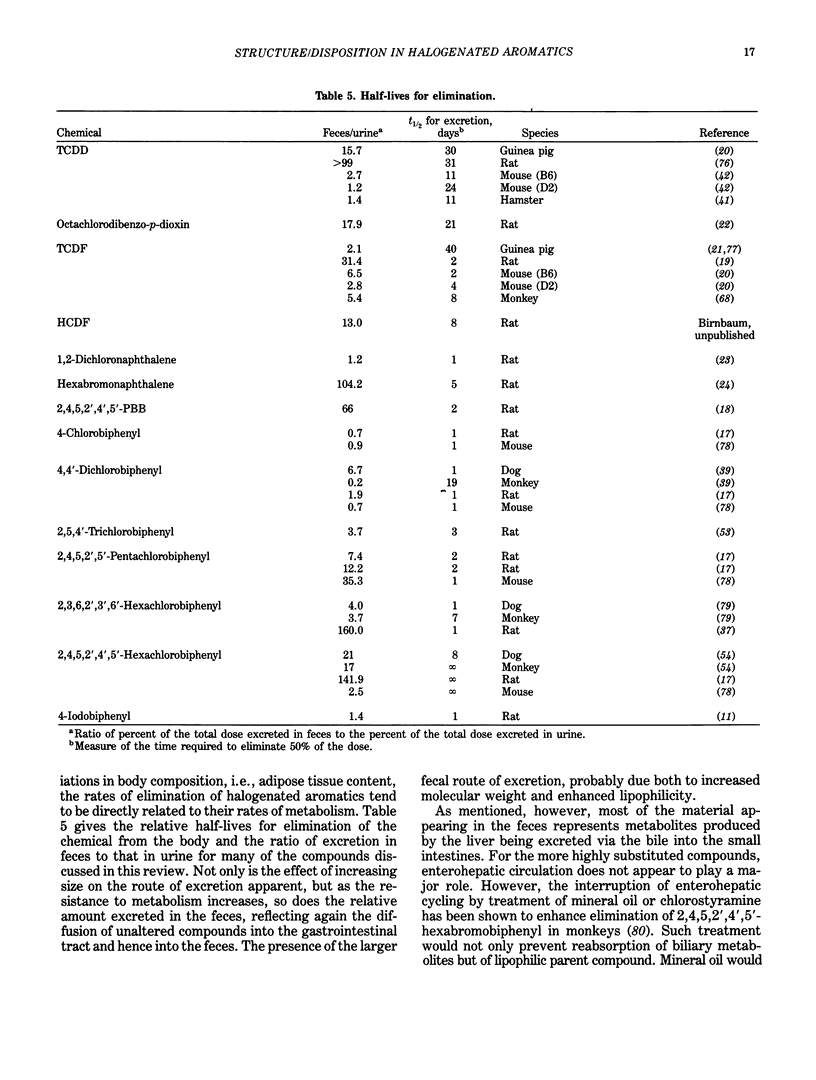
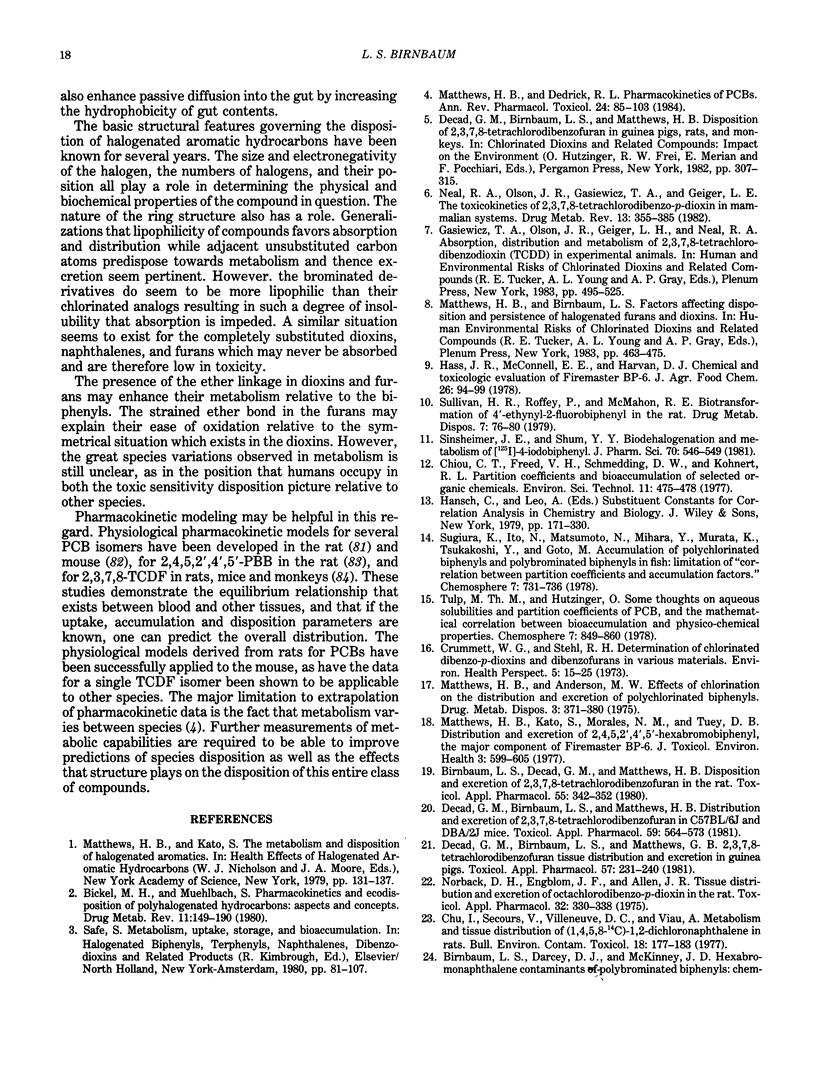
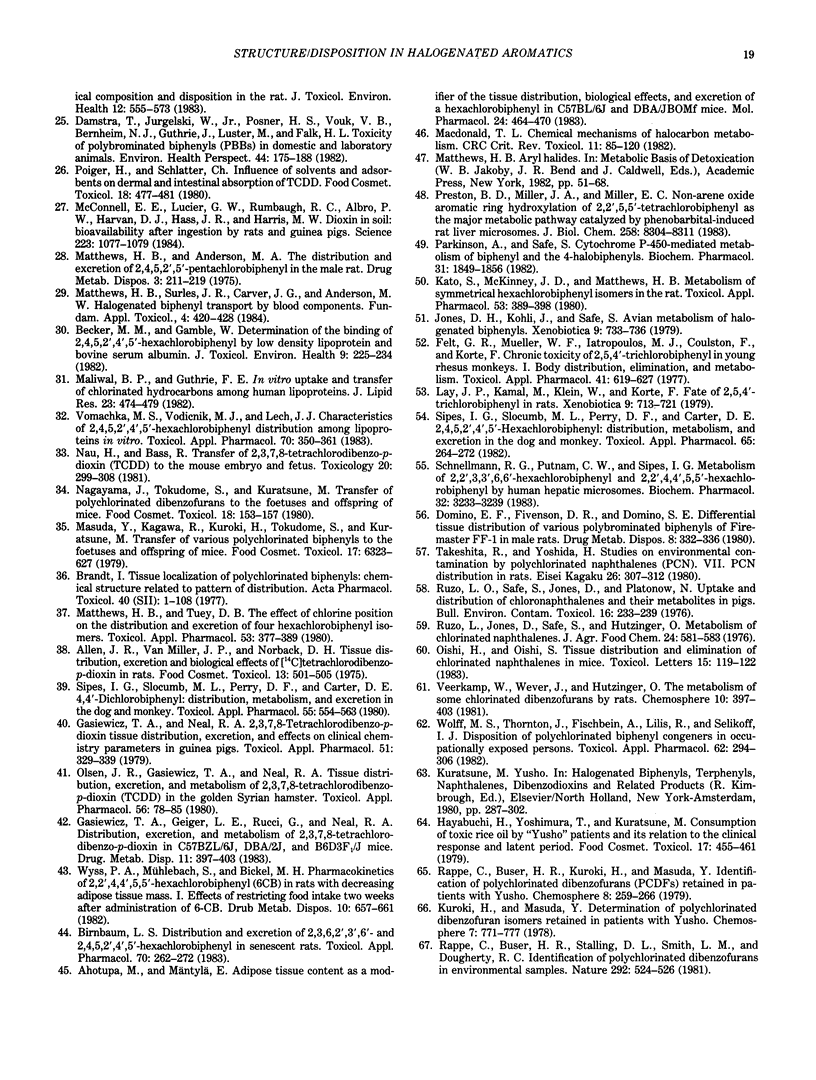
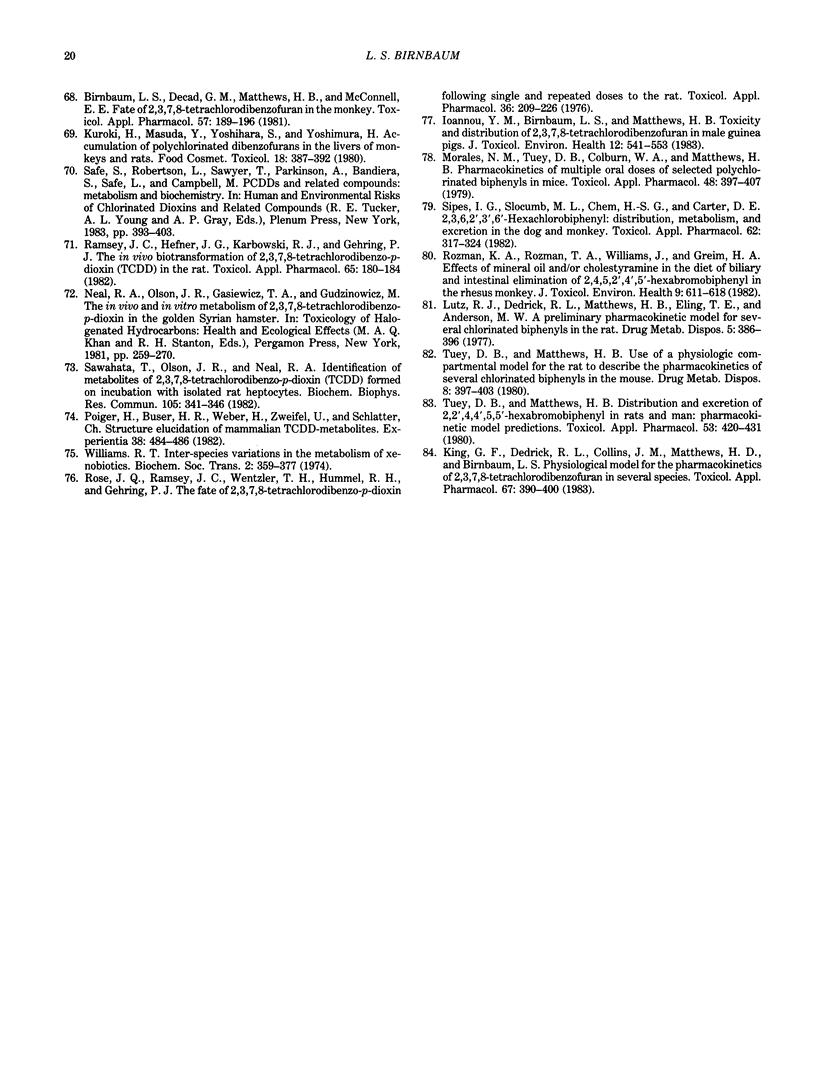
Selected References
These references are in PubMed. This may not be the complete list of references from this article.
- Ahotupa M., Mäntylä E. Adipose tissue content as a modifier of the tissue distribution, biological effects, and excretion of a hexachlorobiphenyl in C57BL/6J and DBA/JBOMf mice. Mol Pharmacol. 1983 Nov;24(3):464–470. [PubMed] [Google Scholar]
- Allen J. R., Van Miller J. P., Norback D. H. Tissue distribution, excretion and biological effects of [14C]tetrachlorodibenzo-p-dioxin in rats. Food Cosmet Toxicol. 1975 Oct;13(5):501–505. doi: 10.1016/0015-6264(75)90002-4. [DOI] [PubMed] [Google Scholar]
- Becker M. M., Gamble W. Determination of the binding of 2,4,5,2',4',5'-hexachlorobiphenyl by low density lipoprotein and bovine serum albumin. J Toxicol Environ Health. 1982 Feb;9(2):225–234. doi: 10.1080/15287398209530157. [DOI] [PubMed] [Google Scholar]
- Bickel M. H., Muehlebach S. Pharmacokinetics and ecodisposition of polyhalogenated hydrocarbons: aspects and concepts. Drug Metab Rev. 1980;11(2):149–190. doi: 10.3109/03602538008994024. [DOI] [PubMed] [Google Scholar]
- Birnbaum L. S., Darcey D. J., McKinney J. D. Hexabromonaphthalene contaminants of polybrominated biphenyls: chemical composition and disposition in the rat. J Toxicol Environ Health. 1983 Oct-Dec;12(4-6):555–573. doi: 10.1080/15287398309530449. [DOI] [PubMed] [Google Scholar]
- Birnbaum L. S., Decad G. M., Matthews H. B. Disposition and excretion of 2,3,7,8-tetrachlorodibenzofuran in the rat. Toxicol Appl Pharmacol. 1980 Sep 15;55(2):342–352. doi: 10.1016/0041-008x(80)90096-4. [DOI] [PubMed] [Google Scholar]
- Birnbaum L. S., Decad G. M., Matthews H. B., McConnell E. E. Fate of 2,3,7,8-tetrachlorodibenzofuran in the monkey. Toxicol Appl Pharmacol. 1981 Feb;57(2):189–196. doi: 10.1016/0041-008x(81)90279-9. [DOI] [PubMed] [Google Scholar]
- Birnbaum L. S. Distribution and excretion of 2,3,6,2',3',6'- and 2,4,5,2',4',5'-hexachlorobiphenyl in senescent rats. Toxicol Appl Pharmacol. 1983 Sep 15;70(2):262–272. doi: 10.1016/0041-008x(83)90102-3. [DOI] [PubMed] [Google Scholar]
- Brandt I. Tissue localization of polychlorinated biphenyls. Chemical structure related to pattern of distribution. Acta Pharmacol Toxicol (Copenh) 1977;40 (Suppl 2):1–108. [PubMed] [Google Scholar]
- Chu I., Secours V., Villeneuve D. C., Viau A. Metabolism and tissue distribution of (1,4,5,8-14C)--1,2-dichloronaphthalene in rats. Bull Environ Contam Toxicol. 1977 Aug;18(2):177–183. doi: 10.1007/BF01686064. [DOI] [PubMed] [Google Scholar]
- Crummett W. B., Stehl R. H. Determination of chlorinated dibenzo-p-dioxins and dibenzofurans in various materials. Environ Health Perspect. 1973 Sep;5:15–25. doi: 10.1289/ehp.730515. [DOI] [PMC free article] [PubMed] [Google Scholar]
- Damstra T., Jurgelski W., Jr, Posner H. S., Vouk V. B., Bernheim N. J., Guthrie J., Luster M., Falk H. L. Toxicity of polybrominated biphenyls (PBBs) in Domestic and laboratory animals. Environ Health Perspect. 1982 Apr;44:175–188. doi: 10.1289/ehp.8244175. [DOI] [PMC free article] [PubMed] [Google Scholar]
- Decad G. M., Birnbaum L. S., Matthews H. B. 2,3,7,8-Tetrachlorodibenzofuran tissue distribution and excretion in guinea pig. Toxicol Appl Pharmacol. 1981 Feb;57(2):231–240. doi: 10.1016/0041-008x(81)90284-2. [DOI] [PubMed] [Google Scholar]
- Decad G. M., Birnbaum L. S., Matthews H. B. Distribution and excretion of 2,3,7,8-tetrachlorodibenzofuran in C57BL/6J and DBA/2J mice. Toxicol Appl Pharmacol. 1981 Jul;59(3):564–573. doi: 10.1016/0041-008x(81)90311-2. [DOI] [PubMed] [Google Scholar]
- Domino E. F., Fivenson D. P., Domino S. E. Differential tissue distribution of various polybrominated biphenyls of Firemaster FF-1 in male rats. Drug Metab Dispos. 1980 Sep-Oct;8(5):332–336. [PubMed] [Google Scholar]
- Felt G. R., Mueller W. F., Iatropoulos M. J., Coulston F., Korte F. Chronic toxicity of 2,5,4'-trichlorobiphenyl in young rhesus monkeys. I. Body distribution, elimination, and metabolism. Toxicol Appl Pharmacol. 1977 Sep;41(3):619–627. doi: 10.1016/s0041-008x(77)80015-x. [DOI] [PubMed] [Google Scholar]
- Gasiewicz T. A., Geiger L. E., Rucci G., Neal R. A. Distribution, excretion, and metabolism of 2,3,7,8-tetrachlorodibenzo-p-dioxin in C57BL/6J, DBA/2J, and B6D2F1/J mice. Drug Metab Dispos. 1983 Sep-Oct;11(5):397–403. [PubMed] [Google Scholar]
- Gasiewicz T. A., Neal R. A. 2,3,7,8-Tetrachlorodibenzo-p-dioxin tissue distribution, excretion, and effects on clinical chemical parameters in guinea pigs. Toxicol Appl Pharmacol. 1979 Nov;51(2):329–339. doi: 10.1016/0041-008x(79)90475-7. [DOI] [PubMed] [Google Scholar]
- Hass J. R., McConnell E. E., Harvan D. J. Chemical and toxicologic evaluation of firemaster BP-6. J Agric Food Chem. 1978 Jan-Feb;26(1):94–99. doi: 10.1021/jf60215a006. [DOI] [PubMed] [Google Scholar]
- Hayabuchi H., Yoshimura T., Kuratsune M. Consumption of toxic rice oil by 'yusho' patients and its relation to the clinical response and latent period. Food Cosmet Toxicol. 1979 Oct;17(5):455–461. doi: 10.1016/0015-6264(79)90004-x. [DOI] [PubMed] [Google Scholar]
- Ioannou Y. M., Birnbaum L. S., Matthews H. B. Toxicity and distribution of 2,3,7,8-tetrachlorodibenzofuran in male guinea pigs. J Toxicol Environ Health. 1983 Oct-Dec;12(4-6):541–553. doi: 10.1080/15287398309530448. [DOI] [PubMed] [Google Scholar]
- Jones D. H., Kohli J., Safe S. Avian metabolism of halogenated biphenyls. Xenobiotica. 1979 Dec;9(12):733–736. doi: 10.3109/00498257909042341. [DOI] [PubMed] [Google Scholar]
- Kato S., McKinney J. D., Matthews H. B. Metabolism of symmetrical hexachlorobiphenyl isomers in the rat. Toxicol Appl Pharmacol. 1980 May;53(3):389–398. doi: 10.1016/0041-008x(80)90352-x. [DOI] [PubMed] [Google Scholar]
- King F. G., Dedrick R. L., Collins J. M., Matthews H. B., Birnbaum L. S. Physiological model for the pharmacokinetics of 2,3,7,8-tetrachlorodibenzofuran in several species. Toxicol Appl Pharmacol. 1983 Mar 15;67(3):390–400. doi: 10.1016/0041-008x(83)90323-x. [DOI] [PubMed] [Google Scholar]
- Kuroki H., Masuda Y., Yoshihara S., Yoshimura H. Accumulation of polychlorinated dibenzofurans in the livers of monkeys and rats. Food Cosmet Toxicol. 1980 Aug;18(4):387–392. doi: 10.1016/0015-6264(80)90195-9. [DOI] [PubMed] [Google Scholar]
- Lay J. P., Kamal M., Klein W., Korte F. Fate of 2,5,4'-trichlorobiphenyl in rats. Xenobiotica. 1979 Dec;9(12):713–721. doi: 10.3109/00498257909042339. [DOI] [PubMed] [Google Scholar]
- Lutz R. J., Dedrick R. L., Matthews H. B., Eling T. E., Anderson M. W. A preliminary pharmacokinetic model for several chlorinated biphenyls in the rat. Drug Metab Dispos. 1977 Jul-Aug;5(4):386–396. [PubMed] [Google Scholar]
- Macdonald T. L. Chemical mechanisms of halocarbon metabolism. Crit Rev Toxicol. 1983;11(2):85–120. doi: 10.3109/10408448309089849. [DOI] [PubMed] [Google Scholar]
- Maliwal B. P., Guthrie F. E. In vitro uptake and transfer of chlorinated hydrocarbons among human lipoproteins. J Lipid Res. 1982 Mar;23(3):474–479. [PubMed] [Google Scholar]
- Masuda Y., Kagawa R., Kuroki H., Tokudome S., Kuratsune M. Transfer of various polychlorinated biphenyls to the foetuses and offspring of mice. Food Cosmet Toxicol. 1979 Dec;17(6):623–627. doi: 10.1016/0015-6264(79)90122-6. [DOI] [PubMed] [Google Scholar]
- Mathews H. B., Anderson M. W. Effect of chlorination on the distribution and excretion of polychlorinated biphenyls. Drug Metab Dispos. 1975 Sep-Oct;3(5):371–380. [PubMed] [Google Scholar]
- Matthews H. B., Anderson M. W. The distribution and excretion of 2,4,5,2',5'-pentachlorobiphenyl in the rat. Drug Metab Dispos. 1975 May-Jun;3(3):211–219. [PubMed] [Google Scholar]
- Matthews H. B., Dedrick R. L. Pharmacokinetics of PCBs. Annu Rev Pharmacol Toxicol. 1984;24:85–103. doi: 10.1146/annurev.pa.24.040184.000505. [DOI] [PubMed] [Google Scholar]
- Matthews H. B., Kato S., Morales N. M., Tuey D. B. Distribution and excretion of 2,4,5,2',4',5'-hexabromobiphenyl, the major component of Firemaster BP-6. J Toxicol Environ Health. 1977 Oct;3(3):599–605. doi: 10.1080/15287397709529592. [DOI] [PubMed] [Google Scholar]
- Matthews H. B., Kato S. The metabolism and disposition of halogenated aromatics. Ann N Y Acad Sci. 1979 May 31;320:131–137. doi: 10.1111/j.1749-6632.1979.tb56596.x. [DOI] [PubMed] [Google Scholar]
- Matthews H. B., Surles J. R., Carver J. G., Anderson M. W. Halogenated biphenyl transport by blood components. Fundam Appl Toxicol. 1984 Jun;4(3 Pt 1):420–428. doi: 10.1016/0272-0590(84)90199-4. [DOI] [PubMed] [Google Scholar]
- Matthews H. B., Tuey D. B. The effect of chlorine position on the distribution and excretion of four hexachlorobiphenyl isomers. Toxicol Appl Pharmacol. 1980 May;53(3):377–388. doi: 10.1016/0041-008x(80)90351-8. [DOI] [PubMed] [Google Scholar]
- McConnell E. E., Lucier G. W., Rumbaugh R. C., Albro P. W., Harvan D. J., Hass J. R., Harris M. W. Dioxin in soil: bioavailability after ingestion by rats and guinea pigs. Science. 1984 Mar 9;223(4640):1077–1079. doi: 10.1126/science.6695194. [DOI] [PubMed] [Google Scholar]
- Morales N. M., Tuey D. B., Colburn W. A., Matthews H. B. Pharmacokinetics of multiple oral doses of selected polychlorinated biphenyls in mice. Toxicol Appl Pharmacol. 1979 May;48(3):397–407. doi: 10.1016/0041-008x(79)90423-x. [DOI] [PubMed] [Google Scholar]
- Nagayama J., Tokudome S., Kuratsune M., Masuda Y. Transfer of polychlorinated dibenzofurans to the foetuses and offspring of mice. Food Cosmet Toxicol. 1980 Apr;18(2):153–157. doi: 10.1016/0015-6264(80)90069-3. [DOI] [PubMed] [Google Scholar]
- Nau H., Bass R. Transfer of 2,3,7,8-tetrachlorodibenzo-p-dioxin (TCDD) to the mouse embryo and fetus. Toxicology. 1981;20(4):299–308. doi: 10.1016/0300-483x(81)90037-8. [DOI] [PubMed] [Google Scholar]
- Neal R. A., Olson J. R., Gasiewicz T. A., Geiger L. E. The toxicokinetics of 2, 3, 7, 8-tetrachlorodibenzo-p-dioxin in mammalian systems. Drug Metab Rev. 1982;13(3):355–385. doi: 10.3109/03602538209029985. [DOI] [PubMed] [Google Scholar]
- Norback D. H., Engblom J. F., Allen J. R. Tissue distribution and excretion of octachlorodibenzo-rho-dioxin in the rat. Toxicol Appl Pharmacol. 1975 May;32(2):330–338. doi: 10.1016/0041-008x(75)90223-9. [DOI] [PubMed] [Google Scholar]
- Oishi H., Oishi S. Tissue distribution and elimination of chlorinated naphthalenes in mice. Toxicol Lett. 1983 Feb;15(2-3):119–122. doi: 10.1016/0378-4274(83)90204-7. [DOI] [PubMed] [Google Scholar]
- Olson J. R., Gasiewicz T. A., Neal R. A. Tissue distribution, excretion, and metabolism of 2,3,7,8-tetrachlorodibenzo-p-dioxin (TCDD) in the Golden Syrian hamster. Toxicol Appl Pharmacol. 1980 Oct;56(1):78–85. doi: 10.1016/0041-008x(80)90132-5. [DOI] [PubMed] [Google Scholar]
- Parkinson A., Safe S. Cytochrome P-450-mediated metabolism of biphenyl and the 4-halobiphenyls. Biochem Pharmacol. 1982 May 15;31(10):1849–1856. doi: 10.1016/0006-2952(82)90487-7. [DOI] [PubMed] [Google Scholar]
- Poiger H., Buser H. R., Weber H., Zweifel U., Schlatter C. Structure elucidation of mammalian TCDD-metabolites. Experientia. 1982 Apr 15;38(4):484–486. doi: 10.1007/BF01952652. [DOI] [PubMed] [Google Scholar]
- Poiger H., Schlatter C. Influence of solvents and adsorbents on dermal and intestinal absorption of TCDD. Food Cosmet Toxicol. 1980 Oct;18(5):477–481. doi: 10.1016/0015-6264(80)90160-1. [DOI] [PubMed] [Google Scholar]
- Preston B. D., Miller J. A., Miller E. C. Non-arene oxide aromatic ring hydroxylation of 2,2',5,5'-tetrachlorobiphenyl as the major metabolic pathway catalyzed by phenobarbital-induced rat liver microsomes. J Biol Chem. 1983 Jul 10;258(13):8304–8311. [PubMed] [Google Scholar]
- Ramsey J. C., Hefner J. G., Karbowski R. J., Braun W. H., Gehring P. J. The in vivo biotransformation of 2,3,7,8-tetrachlorodibenzo-p-dioxin (TCDD) in the rat. Toxicol Appl Pharmacol. 1982 Aug;65(1):180–184. doi: 10.1016/0041-008x(82)90377-5. [DOI] [PubMed] [Google Scholar]
- Rose J. Q., Ramsey J. C., Wentzler T. H., Hummel R. A., Gehring P. J. The fate of 2,3,7,8-tetrachlorodibenzo-p-dioxin following single and repeated oral doses to the rat. Toxicol Appl Pharmacol. 1976 May;36(2):209–226. doi: 10.1016/0041-008x(76)90001-6. [DOI] [PubMed] [Google Scholar]
- Rozman K. K., Rozman T. A., Williams J., Greim H. A. Effect of mineral oil and/or cholestyramine in the diet on biliary and intestinal elimination of 2,4,5,2',4',5'-hexabromobiphenyl in the rhesus monkey. J Toxicol Environ Health. 1982 Apr;9(4):611–618. doi: 10.1080/15287398209530190. [DOI] [PubMed] [Google Scholar]
- Ruzo L. O., Jones D., Platonow N. Uptake and distribution of chloronaphthalenes and their metabolites in pigs. Bull Environ Contam Toxicol. 1976 Aug;16(2):233–239. doi: 10.1007/BF01685233. [DOI] [PubMed] [Google Scholar]
- Ruzo L., Jones D., Safe S., Hutzinger O. Metabolism of chlorinated naphthalenes. J Agric Food Chem. 1976 May-Jun;24(3):581–583. doi: 10.1021/jf60205a007. [DOI] [PubMed] [Google Scholar]
- Sawahata T., Olson J. R., Neal R. A. Identification of metabolites of 2, 3, 7, 8-tetrachlorodibenzo-P-dioxin (TCDD) formed on incubation with isolated rat hepatocytes. Biochem Biophys Res Commun. 1982 Mar 15;105(1):341–346. doi: 10.1016/s0006-291x(82)80050-8. [DOI] [PubMed] [Google Scholar]
- Schnellmann R. G., Putnam C. W., Sipes I. G. Metabolism of 2,2',3,3',6,6'-hexachlorobiphenyl and 2,2',4,4',5,5'-hexachlorobiphenyl by human hepatic microsomes. Biochem Pharmacol. 1983 Nov 1;32(21):3233–3239. doi: 10.1016/0006-2952(83)90209-5. [DOI] [PubMed] [Google Scholar]
- Sinsheimer J. E., Shum Y. Y. Biodehalogenation and metabolism of 125[I]-4-iodobiphenyl. J Pharm Sci. 1981 May;70(5):546–549. doi: 10.1002/jps.2600700521. [DOI] [PubMed] [Google Scholar]
- Sipes I. G., Slocumb M. L., Chen H. S., Carter D. E. 2,3,6,2',3',6'-hexachlorobiphenyl: distribution, metabolism, and excretion in the dog and the monkey. Toxicol Appl Pharmacol. 1982 Feb;62(2):317–324. doi: 10.1016/0041-008x(82)90130-2. [DOI] [PubMed] [Google Scholar]
- Sipes I. G., Slocumb M. L., Perry D. F., Carter D. E. 2,4,5,2',4',5'-Hexachlorobiphenyl: distribution, metabolism, and excretion in the dog and the monkey. Toxicol Appl Pharmacol. 1982 Sep 15;65(2):264–272. doi: 10.1016/0041-008x(82)90009-6. [DOI] [PubMed] [Google Scholar]
- Sipes I. G., Slocumb M. L., Perry D. F., Carter D. E. 4,4'-Dichlorobiphenyl: distribution, metabolism, and excretion in the dog and the monkey. Toxicol Appl Pharmacol. 1980 Sep 30;55(3):554–563. doi: 10.1016/0041-008x(80)90057-5. [DOI] [PubMed] [Google Scholar]
- Sullivan H. R., Roffey P., McMahon R. E. Biotransformation of 4'-ethynl-2-fluorobiphenyl in the rat. In vitro and in vivo studies. Drug Metab Dispos. 1979 Mar-Apr;7(2):76–80. [PubMed] [Google Scholar]
- Tuey D. B., Matthews H. B. Distribution and excretion of 2,2',4,4',5,5'-hexabromobiphenyl in rats and man: pharmacokinetic model predictions. Toxicol Appl Pharmacol. 1980 May;53(3):420–431. doi: 10.1016/0041-008x(80)90355-5. [DOI] [PubMed] [Google Scholar]
- Tuey D. B., Matthews H. B. Use of a physiological compartmental model for the rat to describe the pharmacokinetics of several chlorinated biphenyls in the mouse. Drug Metab Dispos. 1980 Nov-Dec;8(6):397–403. [PubMed] [Google Scholar]
- Vomachka M. S., Vodicnik M. J., Lech J. J. Characteristics of 2,4,5,2',4',5'-hexachlorobiphenyl distribution among lipoproteins in vitro. Toxicol Appl Pharmacol. 1983 Sep 30;70(3):350–361. doi: 10.1016/0041-008x(83)90153-9. [DOI] [PubMed] [Google Scholar]
- Wolff M. S., Thornton J., Fischbein A., Lilis R., Selikoff I. J. Disposition of polychlorinated biphenyl congeners in occupationally exposed persons. Toxicol Appl Pharmacol. 1982 Feb;62(2):294–306. doi: 10.1016/0041-008x(82)90128-4. [DOI] [PubMed] [Google Scholar]
- Wyss P. A., Mühlebach S., Bickel M. H. Pharmacokinetics of 2,2',4,4',5,5'-hexachlorobiphenyl (6-CB) in rats with decreasing adipose tissue mass. I. Effects of restricting food intake two weeks after administration of 6-CB. Drug Metab Dispos. 1982 Nov-Dec;10(6):657–661. [PubMed] [Google Scholar]


